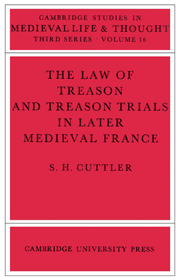Book contents
- Frontmatter
- Contents
- Dedication
- Preface
- Abbreviations
- Introduction
- 1 THE CONCEPT OF TREASON IN LATER MEDIEVAL FRANCE: LEGISTS, ‘COUTUMIERS’ AND TREATISE-WRITERS
- 2 THE CRIMES OF TREASON
- 3 JURISDICTION
- 4 PROCEDURE AND THE TRIAL OF PEERS
- 5 PUNISHMENT, FORFEITURE AND PARDON
- 6 TREASON AND THE CROWN 1328–1356
- 7 TREASON AND THE CROWN 1356–1380
- 8 TREASON AND THE CROWN 1380–1422
- 9 TREASON AND THE CROWN 1422–1461
- 10 TREASON AND THE CROWN 1461–1494
- Conclusion
- Bibliography
- Index
- Frontmatter
- Contents
- Dedication
- Preface
- Abbreviations
- Introduction
- 1 THE CONCEPT OF TREASON IN LATER MEDIEVAL FRANCE: LEGISTS, ‘COUTUMIERS’ AND TREATISE-WRITERS
- 2 THE CRIMES OF TREASON
- 3 JURISDICTION
- 4 PROCEDURE AND THE TRIAL OF PEERS
- 5 PUNISHMENT, FORFEITURE AND PARDON
- 6 TREASON AND THE CROWN 1328–1356
- 7 TREASON AND THE CROWN 1356–1380
- 8 TREASON AND THE CROWN 1380–1422
- 9 TREASON AND THE CROWN 1422–1461
- 10 TREASON AND THE CROWN 1461–1494
- Conclusion
- Bibliography
- Index
Summary
The authority of the French crown in the later middle ages can in part be measured by the extent to which the crown could successfully claim for itself jurisdiction in the prosecution of crime. Since treason was the public crime par excellence, only the king – as the embodiment of public authority – or his delegated officers and institutions could have competence to try it. Such at least was the opinion of most legal theorists and coutumiers. In practice, however, although a multiplicity of royal jurisdictions did indeed take cognizance in most cases of treason, the crown on occasion still had to assert its rights against the pretensions of municipal, seigneurial and above all ecclesiastical courts. But before we examine these conflicts of jurisdiction, let us first consider the variety of royal jurisdictions.
The kings of France by themselves and without any further legal restraint could exercise their authority to pass sentence on accused traitors. The execution of Olivier III de Clisson in August 1343 ‘by judgement of the king’ is a case in point. Not many months later Philippe VI instructed the prèvôt of Paris to execute twelve recently arrested supporters of Jean de Montfort ‘because we condemn them as traitors’. During the first years of Jean II's reign there were more summary executions by royal order. On 18 November 1350, within months of ascending the throne, the new king had the constable, Raoul de Brienne, count of Eu, beheaded for treason. Perhaps the best-known incident of royal judgement without judicial process was the decapitation at Rouen of Jean V, count of Harcourt, Jean Malet, lord of Graville, and two others on 5 April 1356.
- Type
- Chapter
- Information
- Publisher: Cambridge University PressPrint publication year: 1982

